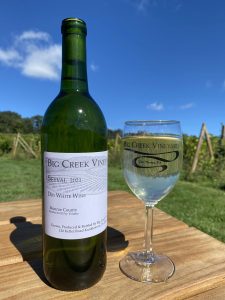Dry White Wine

Our climate is a little more forgiving to our white grapes, compared to the rigors of ripening red ones. Achieving the proper balance of color, tannin, and sweetness for reds takes a lot of time and energy on the vine’s part. Comparatively, the light skinned varieties only need worry about a little aroma and sweetness (potential alcohol which in turn impacts body). Color, aroma, and tannin development are all important ques for our animal friends to know when the grapes are good enough to eat, and the seeds are therefore ripe enough to be “deposited” somewhere down the line.
Please click on the various types of wines to see their flavor profile and description.
after the matriarch of the family, Carmella. After six years, these vines are coming into their own and finding their balance.
Seyval

Stalwart. This venerable old variety from France has been creaking around the world for close to one hundred years, and in our vineyard for twenty-six. Never a problem in the vineyard, always looking happy and content. Versatile in the winery. Depending on the weather of a particular vintage, it can run the taste gamut from austere to lush. It goes well with heavy fish like tuna or salmon, and with spicy chicken dishes.
Moonlight White

Riesling was one of the first varieties we planted back in the day. It grew beautifully, but would rarely ripen enough to make a classic wine. Riesling needs a lot longer growing season than we can give it in most years. Fortunately, the good folks at Cornell University had the answer-Cayuga White. A progeny of Seyval, with a flavor profile similar to Riesling, but ripening much earlier. Excellent with crab legs, or with German sausage and paté.

